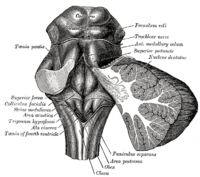
Photo from wikipedia
Rett syndrome (RTT) is a rare neurodevelopmental disorder characterized by severe cognitive, social, and physical impairments resulting from de novo mutations in the X-chromosomal methyl-CpG binding protein gene 2 (MECP2).… Click to show full abstract
Rett syndrome (RTT) is a rare neurodevelopmental disorder characterized by severe cognitive, social, and physical impairments resulting from de novo mutations in the X-chromosomal methyl-CpG binding protein gene 2 (MECP2). While there is still no cure for RTT, exploring up-to date neurofunctional diagnostic markers, discovering new potential therapeutic targets, and searching for novel drug efficacy evaluation indicators are fundamental. Multiple neuroimaging studies on brain structure and function have been carried out in RTT-linked gene mutation carriers to unravel disease-specific imaging features and explore genotype-phenotype associations. Here, we reviewed the neuroimaging literature on this disorder. MRI morphologic studies have shown global atrophy of gray matter (GM) and white matter (WM) and regional variations in brain maturation. Diffusion tensor imaging (DTI) studies have demonstrated reduced fractional anisotropy (FA) in left peripheral WM areas, left major WM tracts, and cingulum bilaterally, and WM microstructural/network topology changes have been further found to be correlated with behavioral abnormalities in RTT. Cerebral blood perfusion imaging studies using single-photon emission CT (SPECT) or PET have evidenced a decreased global cerebral blood flow (CBF), particularly in prefrontal and temporoparietal areas, while magnetic resonance spectroscopy (MRS) and PET studies have contributed to unraveling metabolic alterations in patients with RTT. The results obtained from the available reports confirm that multimodal neuroimaging can provide new insights into a complex interplay between genes, neurotransmitter pathway abnormalities, disease-related behaviors, and clinical severity. However, common limitations related to the available studies include small sample sizes and hypothesis-based and region-specific approaches. We, therefore, conclude that this field is still in its early development phase and that multimodal/multisequence studies with improved post-processing technologies as well as combined PET–MRI approaches are urgently needed to further explore RTT brain alterations.
Journal Title: Frontiers in Neurology
Year Published: 2022
Link to full text (if available)
Share on Social Media: Sign Up to like & get
recommendations!